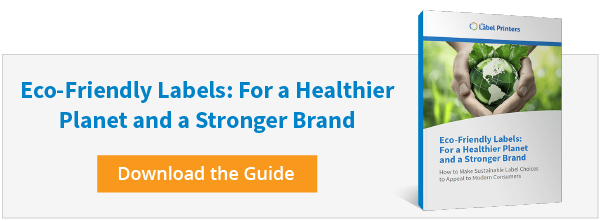
Guide to Product Label Design
Wow your customers – while saving time and money
Product Label Design Is an Art Form
Some of the most talented, creative and clever designers working today have ushered in an era of collectible-quality label design.
But product label design is an art form with a purpose.
Your product label tells a story — often several stories — using the language of color, shape, texture, imagery and text. Whether your story captivates, intrigues, bores, or bothers potential new buyers depends largely on your product label design.
You may think your product label is fit for the Guggenheim, but if it doesn’t speak to the right consumers, it won’t do its brand-boosting job.
This guide is all about designing a product label for form and function.
- First, we’ll examine the preliminary steps that will set you up for success, like figuring out your designer options and the goals for your label.
- Then, we’ll walk through the many elements to consider in your design, like branding, required information, sustainability and the application surface, so you (or your designer) can nail the perfect design that much easier, faster and more cost-effectively.
Whether you’re designing your first product label or refreshing a classic, this guide will help you through each step toward creating a stunning label that will make your product sing.
To jump to a specific section, click on one of the links below.
Want to read this later? Download the PDF.
Part 1: Preparing to Create a Label Design
Done right, product label design isn’t quite as simple as reaching for the closest napkin and sketching out your latest creative vision. As with everything involved with launching and marketing a product, label design calls for careful planning.

First, Decide What You’re Willing to Invest
The first thing to plan is your label budget. Your budget should cover printing costs and the cost of designing the label.
If you opt for a professional designer (an option we’ll discuss below), you may discover that the design phase costs significantly more than expected. Certain premium label features — such as water-resistant coatings or brand protection elements — may also increase your costs.
Resist the urge to skimp on label design and label printing costs. While it’s important to get the most for your money, a product label is often a customer’s first experience of a brand — and first impressions count:
64%
64% of consumers try a new product because the package catches their eye.
40%
Up to 40% of consumers will change their minds when they get to the store based on something they see, learn or do (even if they’ve researched brands ahead of time).
77%
In a study of wine bottle labels, the most visible labels attracted up to 77% more consumers and held their attention up to 2.5 times longer.
These statistics make a clear case for viewing your label design and printing budget not as expenses, but as smart investments in your product’s success.
Expert Tip: The right label printer can help you find ways to save money on your labels. For example, they can often suggest materials, inks, or adhesives that can achieve your objectives for less money.
Next, Choose a Designer
Your label designer is the person who will distill your brand’s identity, story, and vision down into a few square inches of product label. This person might be you, or you might choose to invest in the services of a graphic design professional. There are benefits and drawbacks to either approach.
Let’s look at three options along the amateur-professional label design spectrum:
Graphic Design Option #1: Do It Yourself
If you or someone in your organization has graphic design training and experience and has mastered design tools such as Adobe Illustrator and Photoshop, then the DIY approach to label design might be a viable and affordable option.
If you lack design expertise but still have a clear (and relatively uncomplicated) vision for your label, you might still be able to try creating your own design. Online tools such as Canva make professional-looking design accessible to those lacking formal training or the budget for expensive software.
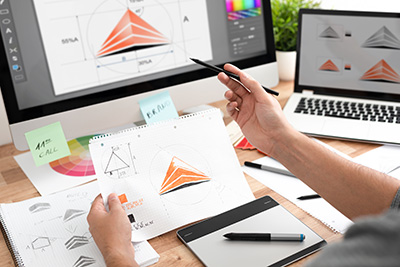
Pros
- DIY design is the most affordable label design option.
- There’s no need to share your brand standards and messaging with an outsider.
- DIY design can be a fun creative outlet.
- If you do decide to hire a designer instead, playing with designs first can give you a better idea of what you like and don’t like.
Cons
- You could inadvertently make costly design mistakes — or just a lackluster look that falls flat with consumers.
- An in-house design effort could consume time and resources that would be better spent on other things.
Graphic Design Option #2: Hire a Less Experienced Professional Designer
You don’t necessarily need to hire an award-winning design firm to produce an eye-catching product label. Talented graphic designers are available at nearly every price point — if you know where to find them.
Websites such as 99designs, Fiverr, and Upwork help up-and-coming graphic designers around the world showcase their work and get found by clients like you. Local colleges might also put you in touch with recent graduates looking to break into the design business, or current students looking to put their new skills into practice.
And of course, check with your label printer! They may have resources on staff or be able to make recommendations for experienced label designers.

Pros
- Less experienced designers are typically excited for the opportunity to design a product label and will charge less than big-name firms. (Do pay them fairly, though – too many new designers get pressured into working “for exposure” by clients looking to stretch their budget.)
- Connecting and communicating with and paying a graphic designer through an online marketplace is usually straightforward. Some online marketplaces allow you to test designers and select the one who makes the best proposal.
- Independent or newly minted graphic designers often have their own distinctive art style, which could result in an exciting and fresh look for your brand. You’ll be able to find everything from in-your-face boldness to ethereal airiness, and everything in between.
Cons
- Less experienced is less experienced. Newer designers may not have their finger on the pulse of what works in the marketplace – and may not be as skilled translating your wishes into a vision, and that vision into a design that accomplishes your goals.
- A less established designer may not be as adept working with design briefs, style guides and brand standards, if they’ve only ever worked with smaller clients.
- Inexperienced designers may not understand how a digital label design translates into a printed label. This can lead to confusion and delays while you sort out file formats, color spectrums, and other issues between your designer and your label printer.
Graphic Design Option #3: Hire an Experienced Professional Designer
Experienced professional graphic designers can work magic with product labels, creating gorgeous, polished looks that blow the competition away.
Some brands have even partnered with world-class artists. (For example, winemaker Château Mouton Rothschild has featured label designs from household names such as Chagall, Picasso, Dali and Koons.)
We’re not recommending you go that far in your search for a label designer, but if you have the budget for a high-end designer, the results can be spectacular.
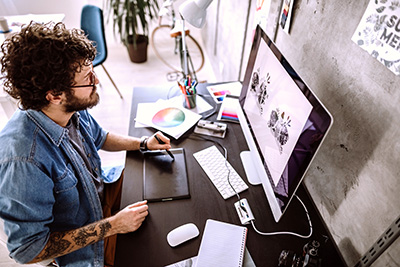
Pros
- Veteran professional designers have the expertise, training and real-world experience to create something truly unique that captures the exact mood and message you’re looking for..
- Experienced graphic designers know how to ask the right questions to work seamlessly with you and your label printer.
Cons
- This is by far the most expensive label design option.
- In-demand professionals might have many other clients to deal with and may not be able to give you their full attention.
(P.S. If you’re looking for a top-notch label designer, we recommend Gary Carbon at Carbon3Sixty, who kindly contributed his expertise and time to help us create this guide.)
STOP! Don’t Talk Design Yet!
Sorry to yell, but this is important.
Picture it: After weeks (or months) of effort, the final design for your product label is approved.
It’s perfect.
It’s exactly what you wanted.
It … totally won’t work with the shape of your product packaging.
To prevent costly mistakes like this, once you know roughly how you want your label designed, it’s time to bring two partners into the conversation: A designer, and your label printer.
Your label printer can provide valuable information about the cost and feasibility of your label. Drawing on their experience and expertise, a good label printer can recommend alternative materials or suggest design tweaks to boost your label’s performance, reduce its cost or both.
For this reason, be careful not to leave your label printer out of the conversation until it’s too late to make any necessary changes. Any experienced label printer will tell you it’s always more affordable and less disruptive to avoid mistakes in the first place, than deal with consequences later.
Expert Tip: Bring your label printer into the label design conversation early – they can help you spot potential cost savings … and ways to avoid snags or delays.
Once You DO Talk Design…
Whether you appoint someone within your own organization, pick a designer off an online marketplace, or hire a high-end professional graphic designer, your designer should be familiar with the specifics of label construction. Great label design should account for the label’s physical properties and the label printing process.
An experienced label designer will ask you about:
- Branding. How will your label’s visual style align with your other brand assets, such as advertising and in-store displays?
- Messaging. What should people take away from viewing your product label? What should they absolutely not take away?
- Size and shape. Do you want a standard rectangular label or something more distinctive like a star or teardrop? Do you have the budget for custom die cutting?
- Colors. What are your brand colors (or do you need help choosing new ones)? How much variance in these colors will you tolerate?
- Fonts. Do you have specific brand fonts? How important is readability to your target audience?
- Materials. Different label materials can affect how a label appears when printed. Do you plan to use paper or film? Will you require durable label materials?
- Packaging. How will the label design look when placed atop your product packaging? Will it clash, blend in or pop?
Bring your label printer in on these conversations and encourage dialogue between them and your designer throughout the design stage. That way, the finished design will work with your printing options and budget … and prevent a lot of rework and frustration.
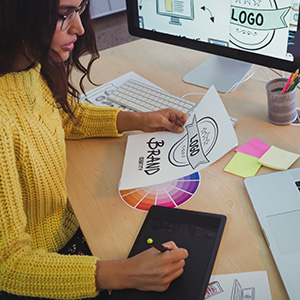
Finally, Outline Your Goals
Before they can start designing your product label, most designers will ask you to complete a detailed brief outlining your visual preferences and your objectives for your label.
Even if you’re designing your label in-house, creating this brief is a valuable exercise. Outlining your goals will give you a reference point, so your label design and printing processes won’t stray off track.
Your creative brief should include:
A clear message
A description of your target audience
Information about your competitors
Your sustainability goals
Part 2: Designing Your Product Label
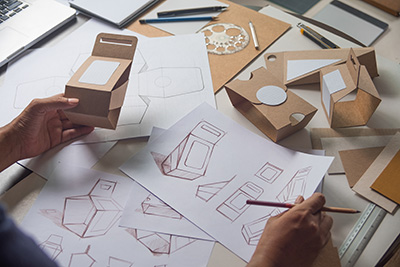
Now that you’ve defined your audience and messaging, it’s time to design your product label.
Product label design is really an exercise in branding. The goal is to help your product stand out (in a good way!) by showcasing the qualities that make your brand and your customers unique.
For example, many craft beer and hot sauce brands use irreverent humor to highlight their rebellious sides. Top-shelf spirits brands may take the opposite approach, choosing classic motifs to evoke longevity and timeless quality. In the health and beauty industry, natural imagery and gentle colors are soothing, while clinical fonts and minimalistic design offer the assurance of science-backed efficacy. Retro (or vintage) label design is also popular in nearly every product category.
Whatever brand image you settle on for your product label, you have the same basic set of tools at your disposal to express it. Here are the many things to consider during the label design process.
New to the label design process? Get up to speed on the label design and printing terminology that will help you navigate like a pro!
Label Colors
Some of the most well-known brands on the planet can be identified by their colors alone. Just think how quickly Coca-Cola red, UPS brown, or John Deere green pop into your mind.
According to an oft-cited statistic (ultimately attributed to a Loyola University study), “Color increases brand recognition by up to 80%.” Meanwhile, leading color consultant Jill Morton (who has helped brands such as Xerox and Tylenol choose instantly iconic colors) writes that color aids memory:
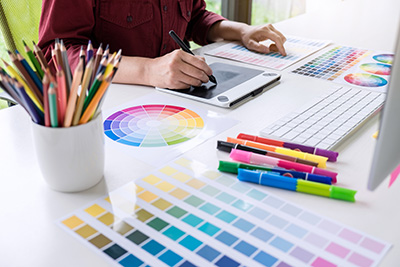
If you already have well-defined brand colors, you’ll want to make sure your designer integrates those colors into your label. If absolute color fidelity is important to you, your label printer may suggest using a spot color, typically identified using the Pantone Color Matching System. Keep in mind that use of spot colors may increase your label costs.
Whether you have predetermined brand colors or not, discuss colors with your label printer well ahead of printing your labels. Most well-equipped print shops possess the technology to replicate a broad spectrum of colors, but their capabilities are not infinite. An extended palette may cost you more than you’re willing to spend.
Choosing Brand Colors? Think About Emotions
Psychological researchers have discovered that colors can conjure up powerful emotions. Brands can choose colors based on the feelings they evoke:
Red: love, passion and excitement (as well as anger)
Purple: creativity, wealth and luxury
Green: relaxation, health and nature
Yellow: “sunshine,” “fun,” and “laughter.”
Blue: calmness, security and trust
Orange: vitality, friendliness and energy
Keep in mind that context – and culture – matter. For example, in many Western cultures, the color white is associated with purity, minimalism and serenity. However, in some Eastern cultures, the color white is symbolically linked with death and sadness.
The takeaway? Think carefully about your label colors and how they might be perceived by your target market.
Label Shape
Design-wise, you can do a lot with a rectangle, the most common (and most affordable) label shape. But should you have the budget for it, choosing an unconventional label shape is a powerful way to stand out from the crowd.
Studies show different shapes, like colors, elicit different emotions. Round shapes exude warmth, sharing and community. Angular forms and straight edges indicate professionalism and stability.
Your label printer may need to create custom dies (cutting tools) to make your unconventional label shape, which can affect the cost. So, as with color, speak to your label printer about shape early in the label design process.
Label Size
Don’t assume larger labels automatically get more attention. A smaller label can add to a satisfyingly minimalist aesthetic while letting your product be the star of the show. Smaller labels also consume fewer resources, which can help your company achieve its sustainability goals.
Make sure you choose a label size that comfortably and legibly fits all your messaging and required information. (To gain label real estate without increasing your label’s size, consider fold-out extended content labels.)
Label Substrate
The substrate is the surface onto which your label design is printed. Typical label substrates are paper or plastic film, although occasionally brands choose more exotic materials such as wood or metal.
It’s easy to think of your label substrate as a blank canvas. But the substrate can make or break your label’s look and feel and must be considered during the design phase. For example, natural-looking materials such as kraft paper or cardstock lend a rustic vibe to handmade products. Metallic foil can transform an everyday product into a giftable treasure.
Your label printer can walk you through their selection of label substrates and recommend an option that enhances your label design. (Tip: Substrate color can alter the appearance of ink. Always test your chosen combination of substrate and ink to ensure it produces the color you want.)
It’s easy to think of your label substrate as a blank canvas. But the substrate can make or break your label’s look and feel and must be considered during the design phase.
Container Material
Ideally, product packaging and product labels are designed together to complement each other. For example, if your packaging is clear (such as a glass bottle), you might also choose a clear label to emphasize your product’s purity.
Often, however, brands design their packaging first and then turn their thoughts to labels.
If this is the case for your brand, provide as many details about your product packaging as you can to your label designer. This will help your designer create a label look that aligns with your product packaging.
Your label printer will also inquire about your product packaging so that they can choose the appropriate adhesive for the application surface.
Regulatory Information and Product Label Design
So far in this guide, we’ve discussed elements you choose to include in your product label design. But depending on your product and your region, some label elements are obligatory. Make sure you communicate these requirements to your graphic designer, so they include them in the label design.
Additional Information, Certifications and Seals
Consumers size up product labels in mere moments. You can catch a shopper’s attention with voluntary certifications or seals demonstrating your brand’s commitment to environmental, wellness or socially responsible causes.
Symbols such as the USDA Organic label, the Non-GMO Project seal, the various cruelty-free bunnies, and Fair Trade Certification act as a kind of shorthand for consumers, informing them about your brand’s values at a glance.
If you are targeting socially aware younger generations, certain signifiers are almost essential. For example, nearly three-quarters of millennials say they would pay more for sustainable products. In addition to voluntary certifications (such as Forest Stewardship Council Certification for sustainable use of wood products), your brand can demonstrate its eco-friendliness by including recycling and reuse instructions in your product label design.
You can catch a shopper’s attention with voluntary certifications or seals demonstrating your brand’s commitment to environmental, wellness or socially responsible causes.
Product Label Design Should Not Be a Last-Minute Consideration
We hope this guide has offered some creative inspiration for your next product label. As you’ve undoubtedly learned, label design should not be an afterthought. Products rise and fall based on their labels’ look, feel, messaging and performance.
The best time to begin planning your label design? Now!
And don’t forget to bring your label printer into the discussion as early as possible. Your label printer can be an invaluable information source regarding design possibilities, alternative materials, regulatory requirements and money-saving strategies. An experienced label printer will also steer you away from design ideas that won’t work.
The result? A mistake-free, gorgeously designed product label that wows your customers and makes your brand unforgettable.


